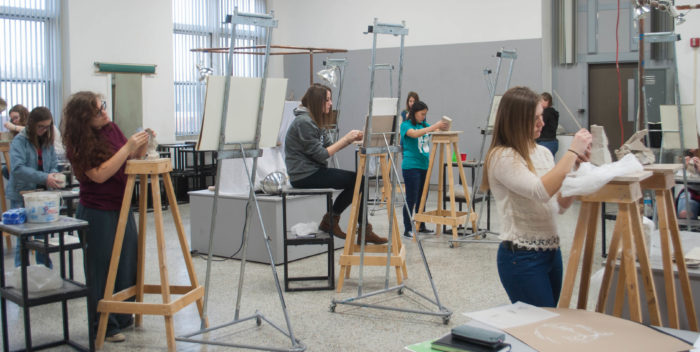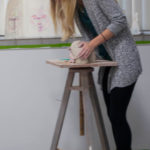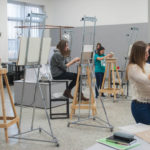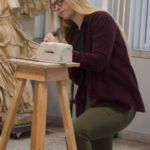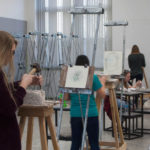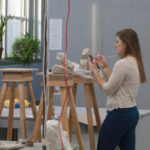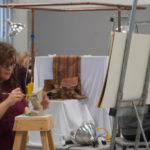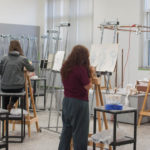Professor Don Robson Redefines Drawing IV Course
Photo by Jordyn Sturms.
by Jordyn Sturms
Professor of Art and Art Department Chair Don Robson is introducing new methods to the Drawing IV class.
The class is based on the human figure, where students work with live models who sit or stand in various poses, and Robson is making gesture drawings are a larger part of the curriculum.
In Robson’s first semester of teaching Drawing IV, he added a new factor to the traditional technique: capturing the form of a drummer in motion. Instead of the typical still poses, Robson searched for an animated drummer from Concordia’s music department so his students could create a gesture drawing.
Gesture drawings capture movement and form in 10 seconds to five minutes. They are about fluidity, energy and line quality change-ups.
“Why don’t we do a gesture drawing of a kinetic object?” questioned Robson.
The artists drew for the length of time that senior Josh Wudtke drummed his beat. The Drawing IV students were challenged to work toward a finished drawing rather than the typical throw-away study, but still capture the energy present in a gesture drawing.
“I hope they learn that there are other definitions of drawing, instead of what they traditionally know to be drawing,” Robson said.
Robson intended capturing a model in the act of drumming as a way to work through the psychology of idealization.
“It’s okay for them not to look ‘perfect’…whatever that is,” Robson said.
He hopes for students to allow themselves permission to move beyond the idea of perfection in drawing.
Juniors Elise Loomis and Sarah Johnson talk about the challenge in making a decision about what to eliminate while capturing a moving figure on paper. Drawing something that sits in one place is much easier than something that is in constant motion. The assignment forced artists to see the object as a whole, rather than get caught up in all the individual parts.
“It helped me work and think and see faster,” Loomis said.
The next Drawing IV assignment involves another unorthodox method, entitled tactile self-portraits. Students draw their face by feeling the features, the textures and the shape. They will not look at the marks they make on the paper. A new type of observation is introduced as artists connect their eyes to what they are feeling, rather than what they are directly looking at.
“Challenge number one: I got ink all over my face…it is meditative, but anxiety-inducing. You can’t see what you’re doing, but you want it to look like something,” Loomis said.
Johnson encourages the use of this assignment in future classes. It is unique from what is studied in the foundational classes.
“It stretches people in a good way,” Loomis said.
“Students don’t always see assignments as creating a work of art, but as an academic piece,” Robson said. “…(I’m) not getting totally away from tradition, but just trying to get people to think a little bit differently about things.”
- Photo by Jordyn Sturms
- Photo by Jordyn Sturms
- Photo by Jordyn Sturms
- Photo by Jordyn Sturms
- Photo by Jordyn Sturms
- Photo by Jordyn Sturms
- Photo by Jordyn Sturms


